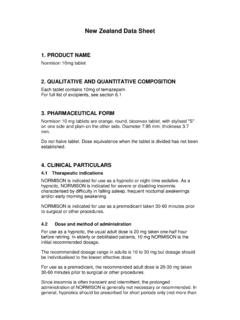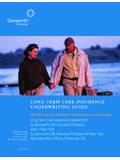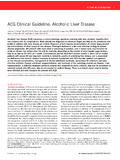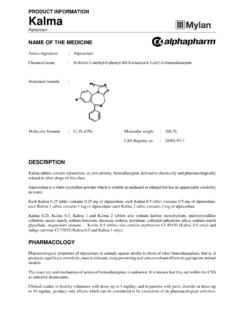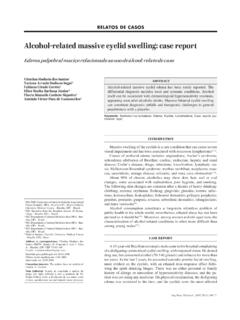Transcription of Chronic Alcohol Abuse and Long Term Complications
1 Chronic Alcohol Abuse and long Term Complications Reviewed September 2017, Expires September 2019 Provider Information and Specifics available on our Website Unauthorized Distribution Prohibited 2017 , , , LLC By Dana Bartlet, RN, BSN, MSN, MA, CSPI INTRODUCTION Alcohol (aka, ethanol, ethyl Alcohol ) is the most commonly abused drug in the United States. Approximately 10% - 15% of all Americans are considered to be Alcohol dependent. Alcohol dependence is defined in the DSM-IV as repeated Alcohol -related difficulties in at least three of seven areas of functioning that cluster together over a 12-month period. A simpler definition is: Alcohol Abuse is repetitive problems in four life areas social, legal, interpersonal, and occupational caused by drinking.
2 Most nurses are familiar with the potentially serious effects of acute Alcohol intoxication. However, the effects of Chronic Alcohol Abuse are perhaps more severe, and there are several Complications of Chronic Alcohol Abuse that can be life-threatening. OBJECTIVES When the learner has finished this module, she/she will be able to: 1. Identify the differences in Alcohol metabolism between non-drinkers and alcoholics. 2. Identify the amount of Alcohol that is considered to be a health risk if ingested daily. 3. Identify two types of neurological damage associated with heavy drinking. 4. Identify three gastrointestinal Complications associated with heavy drinking.
3 5. Identify two cardiac Complications associated with heavy drinking. 6. Identify the basic cause of Alcohol withdrawal syndrome. 7. Identify three signs/symptoms of the Alcohol withdrawal syndrome. 8. Identify two serious Complications associated with the Alcohol withdrawal syndrome. 9. Identify the optimum treatment for delirium tremens. 10. Identify the optimum treatment for Wernicke-Korsakoff syndrome. THE BASICS ABOUT Alcohol alcohols are chemical compounds that are composed of a hydrocarbon and a hydroxyl group. Ethyl Alcohol the intoxicating component of alcoholic beverages is the most commonly used and abused Alcohol .
4 Ethyl Alcohol causes acute intoxication by increasing the activity of a potent inhibitory neurotransmitters, -aminobutryic acid (GABA) and, and interfering with the activity of a potent excitatory neurotransmitters, glutamate. Alcohol is rapidly absorbed and most ethanol is metabolized in the liver by the enzyme Alcohol dehydrogenase (ADH). People who chronically Abuse Alcohol metabolize Alcohol differently. They metabolize Alcohol at a faster rate than non-drinkers. They also develop a functional tolerance: the greater the number of years someone has been drinking, the more Alcohol that person will need to drink to become functionally impaired.
5 The national standard for acute intoxication is an ethyl Alcohol level of 80 mg/dL. This is considered the level that will alter consciousness to the degree that the individual loses the capacity to act with reason and caution. WHAT ARE THE long -TERM EFFCTS OF Chronic Alcohol Abuse ? Chronic Alcohol Abuse causes many well known social problems such as driving while intoxicated, family and personal trauma, suicide, workplace accidents, and interpersonal violence. The Centers for Disease Control estimates that the excessive Alcohol use is the third leading cause of death in the United States. Fewer people are aware of the long -term medical Complications associated with Chronic Alcohol Abuse .
6 However, when Alcohol is abused chronically, it affects virtually every organ system. Excessive, Chronic Alcohol use also worsens and exacerbates pre-existing medical conditions, it significantly increases the risk of developing many diseases, and it shortens life expectancy by at least a decade. Key Point: How much Alcohol will cause irreparable harm to the body? That depends on many factors such as individual tolerance, genetics, pattern and length of use, etc. But the consumption of more than two standard drinks a day (a standard drink is ounces of spirits, 12 ounces of beer, or five ounces of wine) is associated with a significant risk for developing Alcohol -related health issues.
7 Damage to Organ Systems Nervous system: Chronic Alcohol abusers frequently experience blackouts. These are episodes of antegrade amnesia. The sleep patterns of Alcohol abusers are disturbed, and this is a risk factor for the development of cardiac disease. Chronic , high intake of Alcohol also causes peripheral neuropathy in approximately 5% 15% of Alcohol -dependent individuals. Approximately 1% of Alcohol -dependent individuals will develop clinical signs of cerebellar degeneration or atrophy, and 50% will have evidence of atrophy as seen by a CT or MRI scan. Gastrointestinal system: Alcohol is very irritating to the gastric mucosa, and Alcohol is a common cause of hemorrhagic gastritis.
8 Alcoholics are at a higher risk than the general population for developing Mallory-Weiss tears. Alcoholic cirrhosis is one of the two leading causes of esophageal varices. Approximately 30% of all cases of acute pancreatitis are caused by Alcohol Abuse , and approximately 70% - 80% of all cases of Chronic pancreatitis are caused by Alcohol Abuse . Chronic Alcohol Abuse is the second leading cause of cirrhosis. Cirrhosis is characterized by slow destruction of hepatocytes and replacement of functioning liver tissue with scarring and fibrosis. Approximately 30% of all people who chronically Abuse Alcohol will develop alcoholic cirrhosis. These patients will have jaundice, ascites, bleeding disorders, iciteral sclera, and they may develop esophageal varices and/or hepatic encephalopathy.
9 Heart: Chronic drinkers are almost twice as likely as abstainers to develop atrial fibrillation, and heavy drinking increases the risk of developing coronary artery disease by sixfold. Alcohol Abuse also increases the risk of hypertension. Cardiomegaly and cardiomyopathy are relatively common consequences of heavy drinking. Hematopoietic: Chronic , heavy drinking decreases the production of white blood cells and can affect their function. Metabolic: Heavy drinking increases the risk of developing non-insulin dependent/type 2 diabetes. The metabolic syndrome is more common among heavy drinkers. Chronic drinkers are often malnourished; the lack of vitamin B1 (thiamine) in the diet of an alcoholic can have very serious consequences.
10 THE PATHOPHYSIOLOGY OF Alcohol -RELATED ORGAN DAMGE There has been an enormous amount of research on the toxic effects of Alcohol . However, although there are many theories as to why Alcohol damages the liver, the brain, the heart, etc., no one found the definitive answer. The neurological damage caused by drinking is probably caused by damage to myelin and axons, and this is probably caused by thiamine deficiency. Cardiac damage is probably caused by a direct toxic effect of ethanol on the heart, a Chronic low level of inflammation that predisposes to atherosclerosis, or free radical damage caused by shifts in ethanol metabolism.










